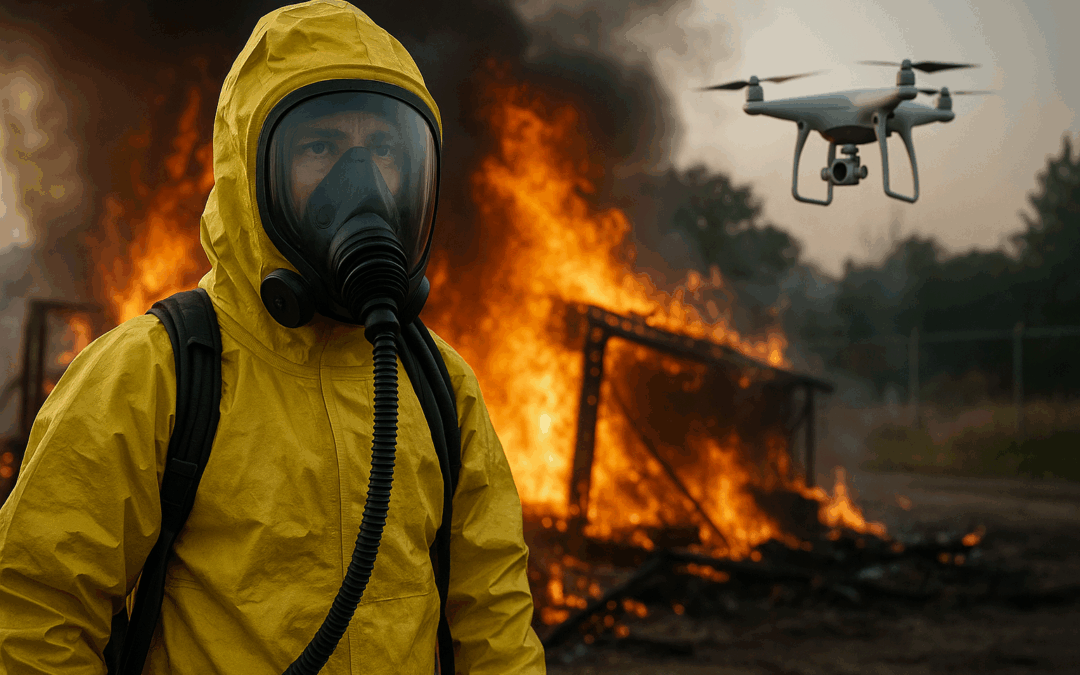From Static Threats to Drones; Evolving Hazmat Response in the Terror Age
This episode was always going to be special. It was episode 420, after all, and while Bobby and Mike joke they missed the chance to turn it into a cannabis-themed episode, they pivot hard into something far more critical: how hazmat response has changed in a world where terrorism keeps adapting.
And trust me, this isn’t theory. It’s experience, frustration, and valuable lessons laid bare by two veterans who’ve lived the shift from post-9/11 panic to modern-day complexity.
Why This Topic Matters Again, and Always Has
We kicked off the show with some laughs, as usual, but quickly moved into serious territory. Terrorism isn’t just a 2000s-era concern. It’s still real. It’s still changing. And as Mike put it, “We thought we’d be going to lots of stuff like this… but it changed.”
They’re not fearmongering – they’re resetting the conversation. And this is just the beginning of what’s going to be a multi-part series on the modern terrorism threat and hazmat’s role in it.
The Return of the Secondary Device
Back in the early 2000s, one of the scariest terms in hazmat was secondary device. That term hasn’t gone away, but the urgency around it has faded. That’s a problem.
“You’d get on the rig and there’d be a label – big letters – ‘SECONDARY DEVICES’, just so you never forgot,” Mike reminded me.
A secondary device is planted not to hurt the public, but to harm the responders coming to help. It’s deception by design, and it’s often timed to perfection.
We talked about several historical examples, including:
- 1997 Atlanta bombing at a family planning center, where a second device targeted responders.
- Puerto Rican peace officer killed by a flashlight rigged as a bomb.
- Boston Marathon bombing, which had an intended second blast point that didn’t go as planned.
These aren’t one-offs. These are templates.
Keeping the Team Alive: What Still Works (and What Doesn’t)
From that old-school awareness comes timeless advice:
- Keep a secure perimeter.
- Follow your protocols (if they’re good ones).
- Stay situationally aware – not just at the scene, but even in the station.
But here’s the problem: “Normalization of deviance” has crept in. We don’t always suit up fully. We take shortcuts. We assume the call is going to be routine.
“We get off for the mundane stuff totally half-dressed,” Mike said. “And that’s a problem.”
He’s not wrong. It only takes one misstep, one assumption, for a responder to pay the price.
PPE and Equipment: We’re Finally Caught Up… Kind Of
What we lacked in 2001, we now have in abundance:
- Active shooter kits (flak vests, helmets)
- Level A suits, radiation blankets, detection vests
- Remote tech like drones, robots, and mesh-networked sensors
This shift in gear is more than convenience – it’s necessity. Hazmat teams today are expected to respond not just to chemicals, but to IEDs, drones, radiological threats, and layered attacks that feel like war zones.
And that brings us to one of the most game-changing evolutions…
The Drone Problem: We’re Not the Only Ones Using Them
Drones have become a standard tool for hazmat teams. But what if they’re turned against us?
“If I was a bad guy, why leave it to chance that a rig parks in the same spot? I’d fly a drone in and pick my target,” Mike said.
They’re cheap. They’re easy to weaponize. And overseas conflicts, like Ukraine, are proving that drones can be accurate enough to drop explosives into tank hatches.
Let that sink in.
Now imagine what that means for a responder walking through a chaotic scene, unable to even hear a drone over the noise of fire rigs and chaos.
Break the Pattern – Literally
Habits save time. But predictable patterns can get you killed.
Responders who always take the same street or park in the same spot are leaving themselves open to calculated attacks. Early hazmat drivers wouldn’t even take the same bridge into Manhattan twice if they could help it.
“If they don’t know what road I’ll be on, they can’t plant something there,” one old-school hazmat driver once said.
The message: adapt or be targeted.
Communication & Command: You Are the Eyes and Ears
One of the best stories from this episode came from Mike recalling a near-miss: a suspicious car loaded with wires, gas cans, and electronics parked outside a Jewish school – with the command post set up right next to it.
He tried to warn people. No one listened.
“I thought I communicated well, but it didn’t matter. I didn’t get through.”
That’s the takeaway. On a real scene, communication is more than words. It’s clarity. It’s persistence. It’s being loud enough, persuasive enough, and urgent enough to push information up the chain.
Practice Like You’re In It
“Drillers make killers,” Mike said, quoting a Brazilian jiu-jitsu mantra.
That applies here. Repetition in drills makes response automatic under stress.
You should be training to spot a secondary device like you train to pull a line or don your SCBA. Drill it into muscle memory, because the moment won’t wait for you to think.
Public Awareness: You Need the Extra Eyes
“If you see something, say something.” It became a cliché, but it worked.
The public can’t stop a drone or disarm a device, but they can be your first alert system. Teaching civilians to report strange behavior, suspicious packages, or out-of-place vehicles is your force multiplier.
Old Tactics vs. New Threats: Static vs. Dynamic Devices
Back in the day, secondary devices were planted in trash cans or behind buildings. But today? Think dynamic threats:
- Remote-controlled drones
- Pressure switches, radio triggers
- Explosives meant to disperse chemicals, radiation, or bioagents
And they don’t just come one at a time. Multiple, simultaneous events can quickly overwhelm even the best-prepared city.
The Mindset Shift: You’re a Piece in a Bigger Puzzle
One of the most honest moments in the episode came when Bobby described gearing up for a call, only to be flanked by a cop with a long gun.
“Your job is to fix that. Mine is to keep you safe,” the officer told him.
For 20 years, Bobby thought he’d be the star of the show. That moment? It broke that ego. Hazmat isn’t the center of the world, it’s one piece in a bigger emergency operation.
Final Thoughts: Be Adaptable. Be Aware. Stay Humble.
We’re not in the same world we were in post-9/11. It’s more connected, more advanced, and in some ways, more dangerous. But it’s also more equipped, more knowledgeable, and better trained – if we choose to be.
That means:
- Drill like your life depends on it.
- Break your routines.
- Push your communication skills.
- Use the public.
- Use your tech.
- Protect your team.
“Ultimately, we want to make effective decisions that allow us – the responders – to go home at night,” Mike said.
That’s the mission. Always has been.
What’s Next from The Haz Mat Guys?
Bobby and Mike also teased two exciting upcoming series:
- The Battery Destroyers Club (Dec 13, 2023):
A video watch party and expert panel dissecting real-world battery explosions, featuring partners like FLIR, Teledyne, Blackline, and more. - After Action Report Podcast (Jan 3, 2024):
A new series preserving the stories of hazmat’s founding members – starting with Mike Callen.
Both shows will be live on YouTube and Facebook. Expect interactivity, no time limits, and lots of wisdom.
Call to Action
If you’re in fire, EMS, hazmat, or just a student of crisis management – now’s the time to revisit your response playbook.
✅ Are your drills accounting for dynamic threats like drones?
✅ Have you reviewed your secondary device protocols?
✅ Do your teammates know what to do if you yell “secondary device”?
✅ Are you still training like it’s 2001?
Let’s talk. Drop your thoughts, questions, or training stories in the comments. Share this post with your team. And don’t forget to subscribe to The Haz Mat Guys so you don’t miss part 2 of this vital series.


